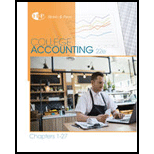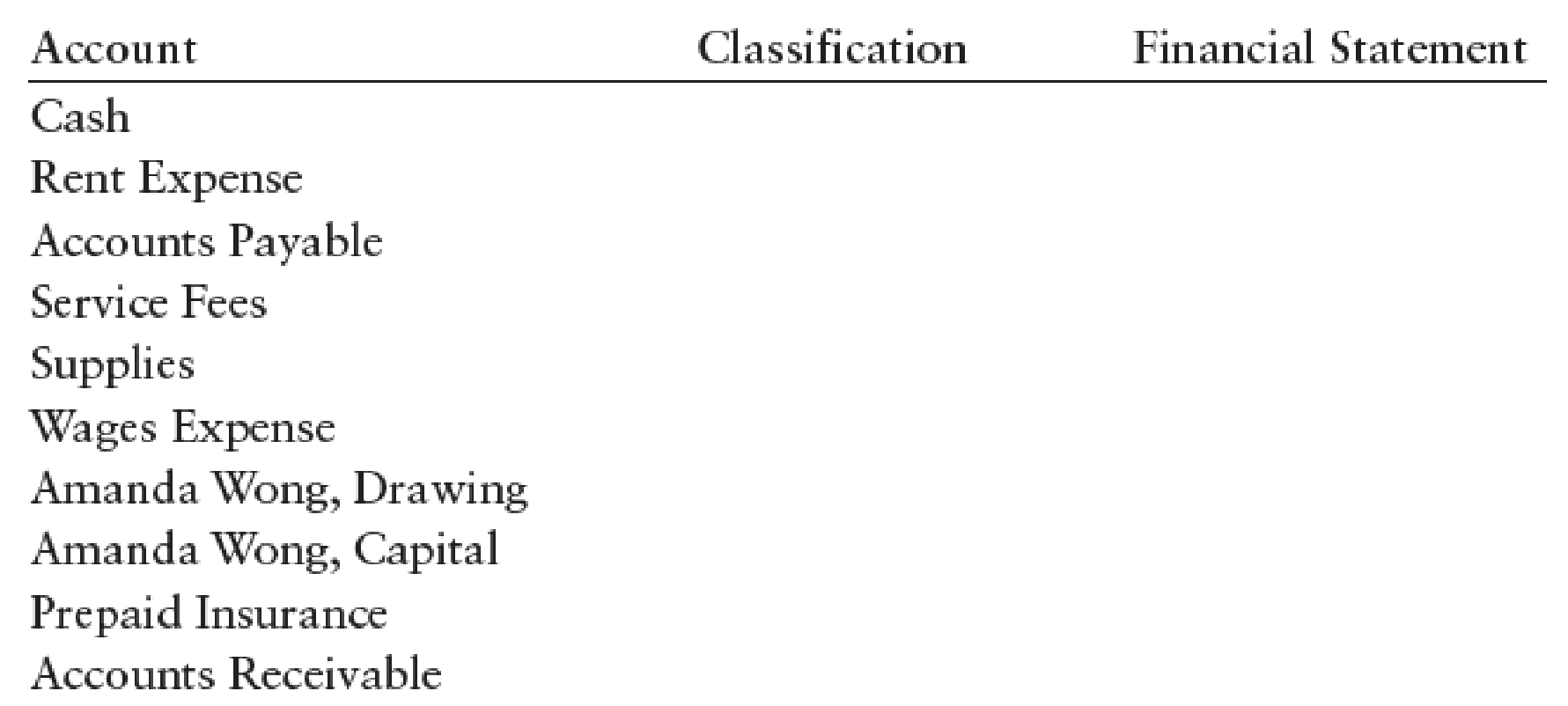
College Accounting, Chapters 1-27
23rd Edition
ISBN: 9781337794756
Author: HEINTZ, James A.
Publisher: Cengage Learning,
expand_more
expand_more
format_list_bulleted
Concept explainers
Textbook Question
Chapter 2, Problem 5SEB
FINANCIAL STATEMENT ACCOUNTS Label each of the following accounts as an asset (A), liability (L), owner’s equity (OE), revenue (R), or expense (E). Indicate the financial statement on which the account belongs—income statement (IS), statement of owner’s equity (SOE), or

Expert Solution & Answer
Want to see the full answer?
Check out a sample textbook solution
Students have asked these similar questions
I want to correct answer general accounting question
What would be the impact on xyz s net income if they accept this special order?
Overhead is closed out to cost of goods sold
Chapter 2 Solutions
College Accounting, Chapters 1-27
Ch. 2 - Prob. 1TFCh. 2 - Accounts Payable is an example of an asset...Ch. 2 - According to the business entity concept,...Ch. 2 - The accounting equation (Assets = Liabilities +...Ch. 2 - When an asset increases, a liability must also...Ch. 2 - Expenses represent outflows of assets or increases...Ch. 2 - When total revenues exceed total expenses, the...Ch. 2 - An increase to which of these accounts will...Ch. 2 - When delivery revenue is earned in cash, which...Ch. 2 - When delivery revenue is earned on account, which...
Ch. 2 - When payment is made on an existing debt, which...Ch. 2 - Which of the following accounts does not appear on...Ch. 2 - Checkpoint Exercises Label each of the following...Ch. 2 - What is missing from the accounting equation...Ch. 2 - What are the effects of the following transactions...Ch. 2 - Classify the following accounts as assets (A),...Ch. 2 - Name and define the six major elements of the...Ch. 2 - Name and define the six major elements of the...Ch. 2 - List the three basic questions that must be...Ch. 2 - Prob. 4RQCh. 2 - Prob. 5RQCh. 2 - Prob. 6RQCh. 2 - What are the three basic phases of the accounting...Ch. 2 - SERIES A EXERCISES ACCOUNTING ELE MENT S Label...Ch. 2 - Prob. 2SEACh. 2 - Assets following (d): 32,200 EFFECTS OF...Ch. 2 - EFFECTS OF TRANSACTIONS (BALANCE SHEET ACCOUNTS)...Ch. 2 - FINANCIAL STATEMENT ACCOUNTS Label each of the...Ch. 2 - STATEMENT OF OWNERS EQUITY REPORTING NET INCOME...Ch. 2 - STATEMENT OF OWNERS EQUITY REPORTING NET INCOME...Ch. 2 - SERIES A PROBLEMS THE ACCOUNTING EQUATION Dr. John...Ch. 2 - EFFECT OF TRANSACTIONS ON ACCOUNTING EQUATION Jay...Ch. 2 - EFFECT OF TRANSACTIONS ON ACCOUNTING EQUATION Jay...Ch. 2 - EFFECT OF TRANSACTIONS ON ACCOUNTING EQUATION Jay...Ch. 2 - EFFECT OF TRANSACTIONS ON ACCOUNTING EQUATION Jay...Ch. 2 - ACCOUNTING ELEMENTS Label each of the following...Ch. 2 - THE ACCOUNTING EQUATION Using the accounting...Ch. 2 - EFFECTS OF TRANSACTIONS (BALANCE SHEET ACCOUNTS)...Ch. 2 - EFFECTS OF TRANSACTIONS (BALANCE SHEET ACCOUNTS)...Ch. 2 - FINANCIAL STATEMENT ACCOUNTS Label each of the...Ch. 2 - STATEMENT OF OWNERS EQUITY REPORTING NET INCOME...Ch. 2 - STATEMENT OF OWNERS EQUITY REPORTING NET LOSS...Ch. 2 - SERIES B PROBLEMS THE ACCOUNTING EQUATION Dr....Ch. 2 - EFFECT OF TRANSACTIONS ON ACCOUNTING EQUATION...Ch. 2 - EFFECT OF TRANSACTIONS ON ACCOUNTING EQUATION...Ch. 2 - STATEMENT OF OWNERS EQUITY Based on Problem 2-9B,...Ch. 2 - BALANCE SHEET Based on Problem 2-9B, prepare a...Ch. 2 - Prob. 1MYWCh. 2 - Prob. 1MPCh. 2 - CHALLENGE PROBLEM In this chapter, you learned...
Knowledge Booster
Learn more about
Need a deep-dive on the concept behind this application? Look no further. Learn more about this topic, accounting and related others by exploring similar questions and additional content below.Similar questions
- nonearrow_forwardCalculate the company's P/E ratioarrow_forwardLegal Corporation purchased a limited-life intangible asset for $600,000 on July 1, 2017. It has a useful life of 12 years. What total amount of amortization expense should have been recorded on the intangible asset by December 31, 2019?arrow_forward
- Total assets? General accountingarrow_forwardAnswer the following, based on the information provided: Calculate the overapplied or underapplied overhead for the year ended December 31, 2024. Be sure to indicate whether the overhead is overapplied or underapplied. If the overapplied or underapplied is material, what is the appropriate accounting treatment for this overapplied or underapplied overhead? Calculate the dollar balance in the work-in-process inventory account as of December 31, 2024. Calculate the dollar balance in the finished goods inventory account as of December 31, 2024, for the estate sprinklers, using LIFO basis. What is the cost of goods sold for the year ended December 31, 2024, using LIFO basis. JOB-ORDER COSTING Garden-R-US Inc. manufactures lawn equipment. The business uses a job-order system because the products are manufactured in batches rather than a continuous basis. The balances in selected general-ledger accounts for the eleven-month period ended November 30, 2024 are presented…arrow_forwardCan you help me with accounting questionsarrow_forward
arrow_back_ios
SEE MORE QUESTIONS
arrow_forward_ios
Recommended textbooks for you
 College Accounting, Chapters 1-27AccountingISBN:9781337794756Author:HEINTZ, James A.Publisher:Cengage Learning,
College Accounting, Chapters 1-27AccountingISBN:9781337794756Author:HEINTZ, James A.Publisher:Cengage Learning, Financial Accounting: The Impact on Decision Make...AccountingISBN:9781305654174Author:Gary A. Porter, Curtis L. NortonPublisher:Cengage Learning
Financial Accounting: The Impact on Decision Make...AccountingISBN:9781305654174Author:Gary A. Porter, Curtis L. NortonPublisher:Cengage Learning Auditing: A Risk Based-Approach to Conducting a Q...AccountingISBN:9781305080577Author:Karla M Johnstone, Audrey A. Gramling, Larry E. RittenbergPublisher:South-Western College Pub
Auditing: A Risk Based-Approach to Conducting a Q...AccountingISBN:9781305080577Author:Karla M Johnstone, Audrey A. Gramling, Larry E. RittenbergPublisher:South-Western College Pub College Accounting (Book Only): A Career ApproachAccountingISBN:9781337280570Author:Scott, Cathy J.Publisher:South-Western College Pub
College Accounting (Book Only): A Career ApproachAccountingISBN:9781337280570Author:Scott, Cathy J.Publisher:South-Western College Pub Intermediate Accounting: Reporting And AnalysisAccountingISBN:9781337788281Author:James M. Wahlen, Jefferson P. Jones, Donald PagachPublisher:Cengage LearningPrinciples of Accounting Volume 1AccountingISBN:9781947172685Author:OpenStaxPublisher:OpenStax College
Intermediate Accounting: Reporting And AnalysisAccountingISBN:9781337788281Author:James M. Wahlen, Jefferson P. Jones, Donald PagachPublisher:Cengage LearningPrinciples of Accounting Volume 1AccountingISBN:9781947172685Author:OpenStaxPublisher:OpenStax College

College Accounting, Chapters 1-27
Accounting
ISBN:9781337794756
Author:HEINTZ, James A.
Publisher:Cengage Learning,

Financial Accounting: The Impact on Decision Make...
Accounting
ISBN:9781305654174
Author:Gary A. Porter, Curtis L. Norton
Publisher:Cengage Learning

Auditing: A Risk Based-Approach to Conducting a Q...
Accounting
ISBN:9781305080577
Author:Karla M Johnstone, Audrey A. Gramling, Larry E. Rittenberg
Publisher:South-Western College Pub

College Accounting (Book Only): A Career Approach
Accounting
ISBN:9781337280570
Author:Scott, Cathy J.
Publisher:South-Western College Pub

Intermediate Accounting: Reporting And Analysis
Accounting
ISBN:9781337788281
Author:James M. Wahlen, Jefferson P. Jones, Donald Pagach
Publisher:Cengage Learning

Principles of Accounting Volume 1
Accounting
ISBN:9781947172685
Author:OpenStax
Publisher:OpenStax College
The ACCOUNTING EQUATION For BEGINNERS; Author: Accounting Stuff;https://www.youtube.com/watch?v=56xscQ4viWE;License: Standard Youtube License